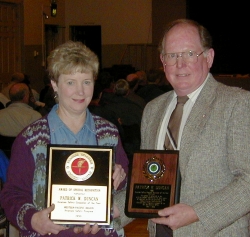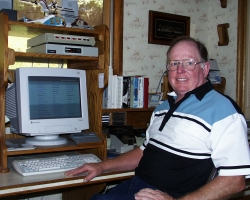 |
Patrick Duncan: FAA Aviation Safety Counselor of the Year 1999 |
 Pat Duncan has been in the aviation business for over 30 years and last year was voted FAA Aviation Safety Counselor of the Year for the Western/Pacific Region and National FAA Aviation Safety Counselor of the Year. FlightAdventures Magazine recently conducted an email interview with Pat and asked him for his views on the use of PC-based flight simulators for everything from basic flight training to improving aviation safety. You'll find he has some interesting insights, and some insightful suggestions for sim developers. Pat Duncan has been in the aviation business for over 30 years and last year was voted FAA Aviation Safety Counselor of the Year for the Western/Pacific Region and National FAA Aviation Safety Counselor of the Year. FlightAdventures Magazine recently conducted an email interview with Pat and asked him for his views on the use of PC-based flight simulators for everything from basic flight training to improving aviation safety. You'll find he has some interesting insights, and some insightful suggestions for sim developers.
FA Mag: How do you think the new breed of retail computer flight simulator programs has influenced the training of new pilots? Pat Duncan: It's difficult to gauge exactly how much or in what way these programs have actually influenced pilot training. I feel very strongly, however, that a truly effective and productive training simulation program must be based totally on realism and incorporate the highest degree of technical accuracy possible. While learning should be fun as well as productive, entertainment aspects included in any serious training sim program cannot negatively impact or detract from the realism and technical accuracy of the training objectives. Current hardware and software technology advancements have evolved to a point where flight simulators can be a tremendous logistic and cost effective asset for flight training. With today's flight costs, simulators can be an excellent economic and safety tool in that pilots can make learning curve mistakes cheaply and safely. One area I feel good, realistic sims can really benefit the G/A pilot is during an instrument rating upgrade program. Use of a good instrument sim program can be extremely helpful in developing IFR flight and communication skills. Playback flight review features are most beneficial to analyze mistakes as well as review areas that need additional finesse.
"Current hardware and software technology advancements have evolved to a point where flight simulators can be a tremendous logistic and cost effective asset for flight training." FA Mag: How useful do you think modern computer flight simulator programs (such as Flight Simulator 2000 and Fly!) are at giving new pilots a head start into flying? Pat Duncan: I feel that current retail sim programs have had a positive impact on exposing non-aviators to the realm of flight, since many of these new programs have incorporated a higher degree of realism as opposed to early generation sims, which were somewhat entertainment orientated. With the rapid advancement of simulation technology, realism, wide screens and fast processors, sim programs can be a tremendous cost effective aid to upstart pilots in accelerating development of their flying skills and as an excellent marketing tool to attract and interest non-pilots in becoming a pilot. However, some of the current programs that I have viewed have far too much entertainment quality and generic overtone to be considered a serious, safe and professionally productive simulation aid. FA Mag: From your experience, how have retail flight sims influenced the knowledge and capabilities of student pilots? Has it been helpful, do you think? Or does it create unrealistic expectations and unsafe flying habits? Pat Duncan: Overall, I feel some existing sim programs are beneficial with respect to helping student pilots base and hone fundamental flight skills and procedures. However, use of an unrealistic or misleading entertainment-based flight sim by a potential pilot could develop some bad habits and unrealistic expectations. Many sims have expanded aircraft sim capabilities well beyond actual or realistic performance limitations of actual aircraft. Reliance on skills developed using unrealistic sim performance could result in disaster for both the student and the CFI. Persons seriously pursuing a flight training program -- who wish to use a sim program -- need to seek guidance from their CFI's, Examiners or ground school instructor on the differences between entertainment and realistic-safe flight simulation programs.
To qualify as a truly worthwhile and productive training tool, I feel that:
What does seriously concern me is the potential negative impact of entertainment flight sims on the kids of today, some of which could easily become the pilot accident statistics of tomorrow due to potential unrealistic expectations and possible pre-programmed initial bad flying habits resulting from impressionable exposure to fantasy and entertainment category sim programs. With current flight sim programs being so popular, technologically advanced and realistic, if I were producing and marketing such a product I would consider incorporating liability disclaimers against potential litigation stemming from 'Sky King' sim users who can't differentiate between fantasy and reality.
"...use of an unrealistic or misleading entertainment-based flight sim by a potential pilot could develop some bad habits and unrealistic expectations." FA Mag: Do you see a downside to using desktop computer flight sims as an adjunct to actual flight training? Pat Duncan: Yes! If such programs are not carefully and realistically written and structured to truly and accurately represent the actual systems, procedures, operational profile and limitations of the represented aircraft and airports used, then a person can be totally misled and possibly develop some very bad initial attitudes and habits -- which could add to the person's (and their CFI's) training costs and frustration levels. Potential pilots need to be made thoroughly aware of the difference between an entertainment sim and one that has actual indoctrination or training value. FA Mag: If you were consulting with a software developer on a new computer flight simulator, what features would you put at the top of your 'must-have' list? Or, put another way: what would you most like to see in future flight sims?
Pat Duncan: If you are referring to a realistic and usable training sim program, some of the truly valuable functions would be:
FA Mag: What do you think of the idea that instrument training gained using a retail product like Flight Simulator 2000 should be used towards Instrument Ratings throughout various aviation governing bodies across the world?
Then there is the question of problems associated with maintaining the program revised with all current communication, airport and NAV data. Such a program could be structured and modified to accommodate Instrument Flight Rules that vary amongst various countries. However, I feel that all regulatory agencies would insist that such a program provide a level of quality and propriety at least equal to conventional methods of instrument training currently used. FA Mag: Aviation safety is a key factor for all aviation governing bodies throughout the world. It's generally accepted that North America, Western Europe and Australia are the safest regions to fly in. Why is that? Could widespread use and acceptance of retail flight simulators as part of a universal safety standards training program promote greater aviation safety? Pat Duncan: I am of the opinion that the three geographic areas referenced above enjoy the highest ratio of safety due primarily to the fact that they all have conservative and highly effective regulatory systems which: 1) mandate certification and operation of the highest level of safe equipment, 2) require strict initial and recurrent certification of pilot airman, 3) Provide strict oversight of equipment and pilot activities and sanction penalties for rule infractions, and 4) all referenced areas utilize modern air traffic control systems. Most of the current free world's aviation regulatory agencies and systems have been patterned to a great extent after the original CAA and FAA -- which was created in 1958 -- to deal with jet age, modern G/A aircraft and the near total reliance on air travel as the prime mode of transportation in the U.S. With respect to worldwide acceptance of retail flight simulators as a safety training aid, while many world countries have adopted many FAA concepts and criteria, there still remains a significant number of regulatory and operational differences amongst many countries. Therefore, it would appear to be a challenge to develop and maintain currency of a universally accepted simulation program standard that would include both commonalties and differences amongst all countries using mutual airspace access. However, one excellent use I can envision for a specialized sim would be an 'International Traveler' program that would contain specific VFR, IFR and operational aviation rules along with aviation port of entry/exit and customs regulations. Such a program could work as follows: Say you decide to fly from the U.S. to Panama for a vacation/sightseeing trip. You could pre-program your route, type of A/C, flight modes (VFR, IFR, GPS, etc.) and any other pertinent data relative to the flight. The program would then display a pre-flight briefing on all regulatory and operational rules, flight services and other information relative to each country you will transverse. Then as you begin your sim flight over the designated routes, the program could display specific visual and/or audio insert reminders about navigation, communication, flight altitudes, restricted airspace or any other regulatory or safety function unique to that country and the area of flight. In essence, you could pre-fly your exact trip and pre-experience the disciplines, needs and pitfalls prior to actually venturing into the unknown. If you want to get real cute, the program could also have some built-in failure/emergency modes such as an inop navaid/communication facility or a primary airport underwater, volcanic obscuration, etc., which could help in pre-flight considerations for alternate airports fuel planning, search/rescue, survival equipment, and so forth.
"I am amazed that Cessna, Piper, Mooney, etc. have not developed model specific mini-sim programs that could be given to prospective buyers or flight schools as way to highlight their features and sell the concept of their product." FA Mag: Do you see the need for any new or creative uses for flight simulation or pilot education programs? Pat Duncan: Glad you asked! YES! YES! YES! I am amazed that Cessna, Piper, Mooney, etc. have not developed model specific mini-sim programs that could be given to prospective buyers or flight schools as way to highlight their features and sell the concept of their product. A full-blown manufacturer's VFR model-specific sim program would even be a better way to go. Such a program would be a tremendous help in transitioning a pilot/owner into a new aircraft, not only from a systems/procedures standpoint, but that careful programming could also provide realistic flight characteristics and capabilities unique to that aircraft. The program could also include a walkthrough on correct manufacturer specifics for pre-flight, fueling, servicing and other special model specific requirements. As another consideration, I would think that provision of such a sim program would also be very attractive to the manufacturer's product and liability insurance underwriter -- as well as the owner/pilot's insurance carrier -- all in the interest of improving safety and reducing risk/loss exposure. One other positive use of sims comes to mind: Differences Training! The air carrier industry is infinitely aware and involved with the importance of providing differences training on fleets having equipment or system differences. G/A has the same problem (look at the many different versions of the Cessna 172 alone), yet there is little or no manufacturer help for training pilots on model or equipment configuration differences. This is a problem for renter pilots who must regularly use identical or similar model aircraft with system or performance differences. Again, enhanced safety as well as reduction in insurance risk/loss could be the benefit here. Another area where flight sims could be a plus would be the development of various school/educational version sims that could be used by educators to introduce kids (and teachers) to aircraft and flight. Such a program could be part video tutorial and part ''let em'' fly, using dampened response that would have talking feedback to tell them when to ''push'', ''pull'', ''turn'', ''pray'', ''bail out'', etc. Might be a way to get kids interested in aviation at an early age and also even dispel some fear of flying. FA Mag: At some stage in the future, do you see on-board aircraft computer technology being able to fly an entire journey and 'deal with' mechanical failures without human aid? Pat Duncan: Hopefully not while I have to fly in these anti-gravity machines. While there are some pretty impressive diagnostic capabilities already available to both the space and aircraft industry, I feel there is still a long way to go before a fool-proof diagnostic/logic system is developed that can effectively (and confidently) select and manage redundant equipment and systems with the anticipated complexity required on future proposed aircraft. That's not to say it can't or won't happen. But until such time as a 99.9 % (or higher) confident system evolves, there is still nothing like the availability of capable human observation and judgment when it comes to decisions and management of an emergency scenario. Can you imagine trying to develop a program that would have got Al Haynes' UAL DC-10 on the ground as good as he did at Sioux City, Iowa? (Ed Note: For a retrospective on the Sioux City crash, see this article in the Sioux City Journal) FA Mag: Would you trust a computer to fly a plane for you? Pat Duncan: With a qualified Pilot on board? Or with only flight computer management personnel onboard? If there was still a fully qualified pilot on board, yes! In reality, we already have that situation to a partial extent with the FADEC engine power management system and full function flight director systems used in certain modern aircraft. However, one need only recall the incident at LAX years ago where both FADEC controlled engines, as I recall, spooled down to flight idle due to a FADEC computer glitch just after T/O over the ocean. Fortunately, a ''quickly aged and grayed'' crew barely recovered without tragedy. I doubt very much that this successful recovery could have been accomplished by a ''total computer command flight control environment'' referenced in the above question. I feel that reliance on total technology management of conventional air transportation, while possibly close to technical reality, has a long way to go before safe application and acceptance. This is especially true in the air carrier field, since an air carrier is ultimately responsibility for the safety of its passengers. I can't envision that carriers would entrust their human cargo entirely to technology without the ability of another qualified human to counter, manage or rectify an error of technology. I am sure the day will come when such technology might be perfected. But industry, regulatory and public acceptance of this concept might take some serious evolution if computer technology alone will command and control the aircraft. FA Mag: What advice would you give to flight simulator fans who now want to go a step further towards piloting a real aircraft?
Pat Duncan: If you are serious about flying in the real world:
One final bit of advice... CHECK NOTAM's!
(Editor's Note: Be sure to check out our AVIATION SAFETY PROGRAM section. |

![[Next]](../buttonNextI.jpg)

 Pat Duncan: The only way I could see this concept safely and realistically accepted by aviation regulatory agencies (and insurance underwriters as well) is if the sim program had a sterile verification mode (similar to the tape module in a cockpit voice recorder or the data record module in a flight data recorder), whereby an instrument student could, when they feel they are ready, perform a pre-programmed lesson on the sim and the results of that lesson be indelibly and securely recorded for electronic transmission to a CFI or authorized training center for review and acceptance or rejection by training program management personnel. Such data could also be retained as individual proof of proficiency for FAA Check Airman or for use in analyzing general weaknesses or deviation trends with skills and/or training programs.
Pat Duncan: The only way I could see this concept safely and realistically accepted by aviation regulatory agencies (and insurance underwriters as well) is if the sim program had a sterile verification mode (similar to the tape module in a cockpit voice recorder or the data record module in a flight data recorder), whereby an instrument student could, when they feel they are ready, perform a pre-programmed lesson on the sim and the results of that lesson be indelibly and securely recorded for electronic transmission to a CFI or authorized training center for review and acceptance or rejection by training program management personnel. Such data could also be retained as individual proof of proficiency for FAA Check Airman or for use in analyzing general weaknesses or deviation trends with skills and/or training programs.
 Most of all remember, commercial sim programs are still just that -- a SIMULATION device. Most current commercial sim programs do not necessarily incorporate full and accurate representation of aircraft equipment, systems or performance. If you get pretty good in the sim and start flying the actual aircraft, don't get cocky or the ground (and your CFI) might give you a quick reality check!
Most of all remember, commercial sim programs are still just that -- a SIMULATION device. Most current commercial sim programs do not necessarily incorporate full and accurate representation of aircraft equipment, systems or performance. If you get pretty good in the sim and start flying the actual aircraft, don't get cocky or the ground (and your CFI) might give you a quick reality check!